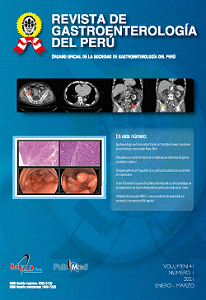The Psychometric Score for Hepatic Encephalopathy and the Stroop EncephalApp in the diagnosis of covert hepatic encephalopathy in Cuba
DOI:
https://doi.org/10.47892/rgp.2021.411.1239Keywords:
Hepatic encephalopathy, Liver cirrhosis, PsychometricsAbstract
Introduction: The early diagnosis of occult hepatic encephalopathy in patients with liver cirrhosis is currently a challenge, mainly with regard to diagnostic tests. Objetive: The aim of this study was to compare the results of two tests, the psychometric score for hepatic encephalopathy and the Stroop EncephalApp in the diagnosis of covert hepatic encephalopathy. Materials and methods: The two tests were applied in patients in the cirrhosis consultation of the "Arnaldo Milián" Hospital in Villa Clara, comparing the results of Stroop EncephalApp taking as reference the psychometric score for hepatic encephalopathy. The variables age, sex and schooling were adjusted according to population norms. Results: A total of 80 cirrhotic patients were included, as well as 520 healthy controls. Using the Stroop EncephalApp, 35% presented covert hepatic encephalopathy, when the Psychometric score for hepatic encephalopathy was used. The prevalence was 40%, showing the sensitivity of Stroop EncephalApp of 80% and 82% of specificity. Conclusions: undiagnosed occult hepatic encephalopathy shows a high prevalence in cirrhosis. The psychometric score for hepatic encephalopathy and Stroop EncephalApp show adequate sensitivity in the diagnosis of occult hepatic encephalopathy.
Downloads
Metrics
Downloads
Published
How to Cite
Issue
Section
License
Revista de Gastroenterología del Perú by Sociedad Peruana de Gastroenterología del Perú is licensed under a Licencia Creative Commons Atribución 4.0 Internacional..
Aquellos autores/as que tengan publicaciones con esta revista, aceptan los términos siguientes:
- Los autores/as conservarán sus derechos de autor y garantizarán a la revista el derecho de primera publicación de su obra, el cuál estará simultáneamente sujeto a la Licencia de reconocimiento de Creative Commons que permite a terceros compartir la obra siempre que se indique su autor y su primera publicación esta revista.
- Los autores/as podrán adoptar otros acuerdos de licencia no exclusiva de distribución de la versión de la obra publicada (p. ej.: depositarla en un archivo telemático institucional o publicarla en un volumen monográfico) siempre que se indique la publicación inicial en esta revista.
- Se permite y recomienda a los autores/as difundir su obra a través de Internet (p. ej.: en archivos telemáticos institucionales o en su página web) antes y durante el proceso de envío, lo cual puede producir intercambios interesantes y aumentar las citas de la obra publicada. (Véase El efecto del acceso abierto).

















 2022
2022 